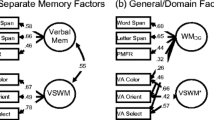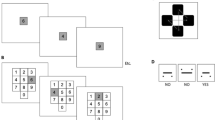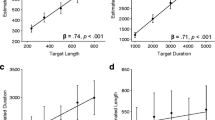Abstract
In this study, we examined the impact of concurrent verbal and visuospatial working memory demands on performance of a visuospatial successive target detection task. Three hundred and four participants performed a visuospatial vigilance task while simultaneously performing either a spatial or verbal working memory task that either required a memory load during the vigil or did not require a memory load during the vigil. Perceptual sensitivity A′ to vigilance target stimuli was reduced by concurrent memory load, both verbal and visuospatial. The decline in perceptual sensitivity to vigilance targets, the vigilance decrement, was steeper for a visuospatial memory task than a verbal memory task, regardless of concurrent memory load. Memory performance after vigilance detection trials was much lower for visuospatial than verbal items, even though memory performance before vigilance detection trials was higher for visuospatial than verbal items. Together, this indicates increased interference when a visuospatial vigilance task is paired with a visuospatial memory task, than when paired with a verbal memory task. Overall, the visuospatial and verbal working memory loads both impacted vigilance target detection, suggesting utilization of common executive resources. There may, however, be domain specific interference, and this may be exacerbated for two visuospatial tasks.



Similar content being viewed by others
References
Baddeley A (2007) Working memory, thought, and action. Oxford University Press, New York
Caggiano DM, Parasuraman R (2004) The role of memory representation in the vigilance decrement. Psycho Bull Rev 11:932–937
Chen Z, Cowan N (2009) How verbal memory loads consume attention. Mem Cogn 37:829–836
Courtney SM, Ungerleider LG, Keil K, Haxby JV (1996) Object and spatial visual working memory activate separate neural systems in human cortex. Cereb Cortex 6:39–49
Cowan N (1995) Attention and memory: an integrated framework. Oxford University Press, New York
Davies DR, Parasuraman R (1982) The psychology of vigilance. Academic Press, London
D’Esposito M, Detre JA, Alsop DC, Shin RK, Atlas S, Grossman M (1995) The neural basis of the central executive system of working memory. Nature 378:279–281
Fan J, McCandliss BD, Fossella J, Flombaum JL, Posner MI (2005) The activation of attention networks. NeuroImage 26:471–479
Ganis G, Thompson WL, Kosslyn SM (2004) Brain areas underlying visual mental imagery and visual perception: an fMRI study. Cogn Brain Res 20:226–241
Gevins A, Smith ME, McEvoy L, Yu D (1997) High-resolution EEG mapping of cortical activation related to working memory: effects of task difficulty, type of processing, and practice. Cereb Cortex 7:374–385
Gluckman JP, Dember WN, Warm JS (1988) Capacity demand in dual-task monitoring of simultaneous and successive vigilance tasks. In: Proceedings of the Human Factors Society 32nd annual meeting, pp 1463–1465
Grier RA, Warm JS, Dember WN, Matthews G, Galinsky TL, Szalma JL, Parasuraman R (2003) The vigilance decrement reflects limitations in effortful attention not mindlessness. Hum Factors 45:349–359
Helton WS, Russell PN (2011) Working memory load and the vigilance decrement. Exp Brain Res 212:429–437
Helton WS, Russell PN (2012) Brief mental breaks and content-free cues may not keep you focused. Exp Brain Res 219:37–46
Helton WS, Warm JS (2008) Signal salience and the mindlessness theory of vigilance. Acta Psychol 129:18–25
Helton WS, Dember WN, Warms JS, Matthews G (2000) Optimism, pessimism, and false failure feedback: effects on vigilance performance. Curr Psychol 18:311–325
Helton WS, Warm JS, Tripp LD, Matthews G, Parasuraman R, Hancock PA (2010) Cerebral lateralization of vigilance: a function of task difficulty. Neuropsychologia 48:1683–1688
Hitchcock EM, Dember WN, Warm JS, Maroney BW, See J (1999) Effects of cueing and knowledge of results on workload and boredom in sustained attention. Hum Factors 41:365–372
Hitchcock EM, Warm JS, Matthews G, Dember WN, Shear PK, Tripp LD, Mayleben DW, Parasuraman R (2003) Automation cueing modulates cerebral blood flow and vigilance in a simulated air traffic control task. Theor Issues Ergon Sci 4:89–112
Kane MJ, Engle RW (2002) The role of the prefrontal cortex in working memory capacity, executive attention, and general fluid intelligence: an individual differences perspective. Psycho Bull Rev 9:637–671
Kane MJ, Hambrick DZ, Tuholski SW, Wilhelm O, Payne TW, Engle RW (2004) The generality of working-memory capacity: a latent-variable approach to verbal and visuospatial memory span and reasoning. J Exp Psychol Gen 133:189–217
Lawrence NS, Ross TJ, Hoffman R, Garavan H, Stein EA (2003) Multiple neuronal networks mediate sustained attention. J Cogn Neurosci 15:1028–1038
Lim J, Wu W, Wang J, Detre JA, Dinges DF, Rao H (2010) Imaging brain fatigue from sustained mental workload: an ASL perfusion study of the time-on-task effect. NeuroImage 49:3426–3435
Logie RH (2011) The functional organization and capacity limits of working memory. Curr Dir Psychol Sci 20:240–245
Macmillan NA, Creelman CD (2005) Detection theory: a user’s guide. Erlbaum, Mahwah
Matthews G, Davies DR (1998) Arousal and vigilance: the role of task factors. In: Hoffman RB, Sherrick MF, Warm JS (eds) Viewing psychology as a whole: the integrative science of William N. Dember. American Psychological Association, Washington, DC, pp 113–144
Matthews G, Davies DR (2001) Individual differences in energetic arousal and sustained attention: a dual-task study. Personality Individ Differ 31:575–589
Matthews G, Warm JS, Reinerman LE, Langheim LK, Saxby DJ (2010a) Task engagement, attention and executive control. In: Gruszka A, Matthews G, Szymura B (eds) Handbook of individual differences in cognition: attention, memory and executive control. Springer, New York, pp 205–230
Matthews G, Warm JS, Reinerman-Jones LE, Washburn DA, Tripp LD (2010b) Task engagement, cerebral blood flow velocity, and diagnostic monitoring for sustained attention. J Exp Psychol Appl 16:187–203
Parasuraman R (1979) Memory load and event rate control sensitivity decrements in sustained attention. Science 205:924–927
Postle BR (2006) Working memory is an emergent property of the mind and brain. Neuroscience 139:23–38
Schneider W, Eshman A, Zuccolotto A (2002) E-prime 2.0 user’s guide. Psychology Software Tools Inc., Pittsburgh
See JE, Howe SR, Warm JS, Dember WN (1995) A meta-analysis of the sensitivity decrement in vigilance. Psychol Bull 117:230–249
Shaw TH, Warm JS, Finomore V, Tripp L, Matthews G, Weiler E, Parasuraman R (2009) Effects of sensory modality on cerebral blood flow velocity during vigilance. Neurosci Lett 461:207–211
Shaw TH, Matthews G, Warm JS, Finomore VS, Silverman L, Costa PT (2010) Individual differences in vigilance: personality, ability and states of stress. J Res Pers 44:297–308
Smith EE, Jonides J (1995) Working memory in humans: neuropsychological evidence. In: Gazzaniga M (ed) The cognitive neurosciences. MIT Press, Cambridge, pp 1009–1020
Smith EE, Jonides J, Koeppe RA (1996) Dissociating verbal and spatial working memory using PET. Cereb Cortex 6:11–20
Stroop JR (1935) Studies of interference in serial verbal reactions. J Exp Psychol 18:643–662
Temple JG, Warm JS, Dember WN, Jones KS, LaGrange CM, Matthews G (2000) The effects of signal salience and caffeine on performance, workload and stress in an abbreviated vigilance task. Hum Factors 42:183–194
Warm JS (1984) An introduction to vigilance. In: Warm JS (ed) Sustained attention in human performance. Wiley, Chichester, pp 1–14
Warm JS (1993) Vigilance and target detection. In: Huey BM, Wickens CD (eds) Workload transitions: implications for individual and team performance. National Academy Press, Washington, pp 139–170
Warm JS, Parasuraman R, Matthews G (2008) Vigilance requires hard mental work and is stressful. Hum Factors 50:433–441
Wickens CD (1976) The effects of divided attention on information processing in tracking. J Exp Psychol Hum Percept Perform 2:1–13
Wickens CD (2008) Multiple resources and mental workload. Hum Factors 50:449–455
Author information
Authors and Affiliations
Corresponding author
Rights and permissions
About this article
Cite this article
Helton, W.S., Russell, P.N. Visuospatial and verbal working memory load: effects on visuospatial vigilance. Exp Brain Res 224, 429–436 (2013). https://doi.org/10.1007/s00221-012-3322-2
Received:
Accepted:
Published:
Issue Date:
DOI: https://doi.org/10.1007/s00221-012-3322-2




